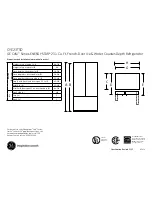
Care and maintenance
Page EN-23
meantime, wrap it up in a thick layer of
newspaper and store it in a cool room or
in an insulated bag while it is defrosting.
4. Remove the drawers (10) and (11) the
sliding drawer (12) from the freezer. Wash
them in warm water with washing-up liq-
uid and dry thoroughly.
5. To clean the fridge, remove the fresh food
drawer (13), the fruit/vegetable draw-
er (15) and the glass shelves (16) and
(18).
6. To remove the glass shelves, lift them
slightly at the front and then pull them out
of the guide rail.
7. In order to remove the door shelves, sim-
ply pull them upwards out of the holders.
8. Clean all of the parts in lukewarm soapy
water. Then dry everything thoroughly.
9. Wash the interior with warm water and
washing up liquid.
10. When wiping clean, add a few drops of
vinegar to the water to prevent mould
from forming.
11. Wipe the appliance’s interior dry.
12. Only clean the door seals with clean wa-
ter; they are sensitive to oil and fat.
13. Replace the glass shelves, the drawers
and the door shelves.
14. Return the food to the fridge or freezer.
15. Push the mains plug back into the sock-
et and set the temperature in the fridge
and freezer to the lowest possible values
(+2 °C and –22 °C), as described in the
section “Setting the temperature” from
page EN-12 onwards.
16. As soon as the freezer has reached a
temperature of –18 °C, switch the tem-
peratures in the fridge and freezer back
to the previous values as described in
section “Setting the temperature” from
page EN-12 onwards or in section “Setting
the operating modes” from page EN-14 on-
wards.
Interior light
WARNING
Risk of electric shock!
Touching live parts may result in severe
injury or death.
■
Do not remove the cover from the in-
terior lighting.
■
Do not attempt to replace the interi-
or light.
Maintenance-free LEDs are used as lights. If
the interior light does not work, please con-
tact our service department (see page EN-32).
The LED lighting in this appliance is rated en-
ergy-efficiency class G.













































